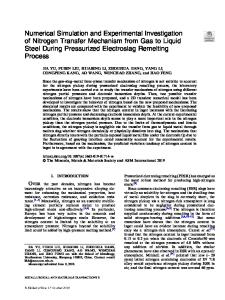Study of failure mechanism of bottom-hole rock mass approaching a gas - fractured zone during nitrogen drilling
- PDF / 1,585,880 Bytes
- 9 Pages / 595.276 x 790.866 pts Page_size
- 15 Downloads / 279 Views
ORIGINAL PAPER
Study of failure mechanism of bottom-hole rock mass approaching a gas-fractured zone during nitrogen drilling Luo Chengbo 1,2 & Jiang Zujun 1 & Li Gao 2 & He Long 3 & Ou Biao 1 & Meng Yingfeng 2 & Xiao Guoyi 1 & Yan Yancheng 1 & Wang Xiyong 1 Received: 29 May 2020 / Accepted: 6 October 2020 # Saudi Society for Geosciences 2020
Abstract In order to restore the normal development of nitrogen drilling technology, it is significant to gain a deep and comprehensive insight into the bottom-hole rock failure mechanism induced by gas-induced fracture. In this paper, the mechanism of bottomhole rock failure induced by gas-induced fracture was analyzed by means of conventional analysis method of wellbore instability. The research suggests when the bottom-hole is gradually approaching the gas-induced fracture, the difference between circumferential stress and radial stress of the crack face gradually increases. The increasing shear stress caused by the difference between principal stresses leads to the compression-shear failure; then, the failure mode evolved from single-shear failure mode to combined mode of shear and tensile failure with the failure zone extending. If the wellbore is connected with the fracture, then the high-pressure gas in fracture carrying plenty of debris is injected into the wellbore, releasing lots of energy. The mechanism analysis of bottom-hole rock failure can explain the abnormal behaviors of logging data in well QL1 located in Baimamiao structural belt, Dayi County, Sichuan Province. The results not only provide a theoretical basis for the prevention and control of bottom-hole rock failure, but also provide a new perspective for studying the dynamic instability of deep rock in the field of petroleum engineering. Keywords Nitrogen drilling . Effective stress . Failure . Fracture . Tight sandstone . Bottom-hole
Introduction Nitrogen drilling technology uses compressed nitrogen as circulating medium for drilling, which is a high-efficiency drilling technology for developing tight sandstone gas reservoirs. It not only fundamentally avoids reservoir damage caused by invasion of drilling mud but also can improve the rate of
Responsible Editor: Santanu Banerjee * Luo Chengbo [email protected] 1
Petroleum Engineering Technology Research Institute, Sinopec Southwest Oil & Gas Branch, Deyang 618000, Sichuan, China
2
State Key Laboratory of Oil and Gas Reservoir Geology and Exploitation, Southwest Petroleum University, Chengdu 610500, Sichuan, China
3
Sinopec Southwest Oil & Gas Branch, Chengdu 610059, Sichuan, China
penetration to a large extent, reduce drilling accidents, and shorten the time used for well construction. Wellbore instability is a severe problem in the process of drilling (Liu and Luo 2004; Deng et al. 2008). It is always a spotlight in drilling operations because of the costly consequences, including borehole collapse, lost circulation, and stuck pipe. Besides, wellbore instability often delays the exploration and development of oil and gas reservoirs and affects th
Data Loading...











